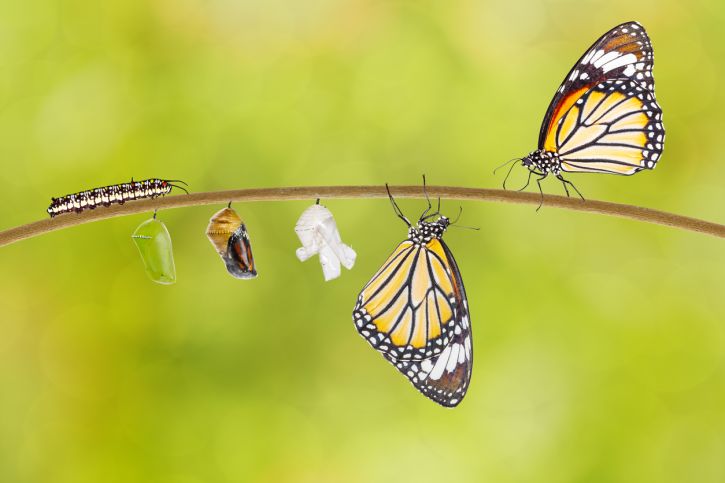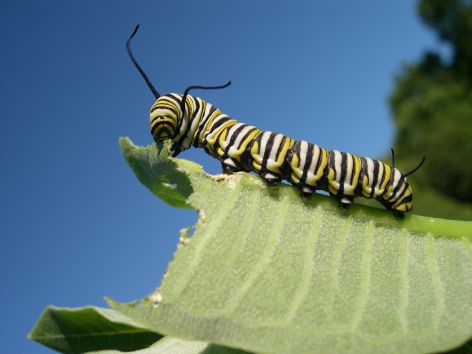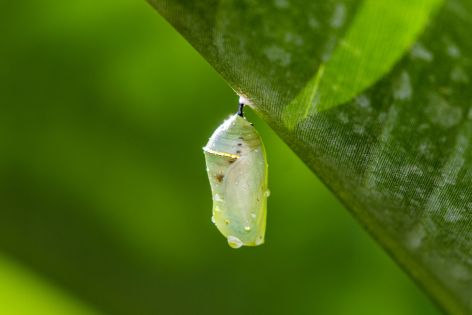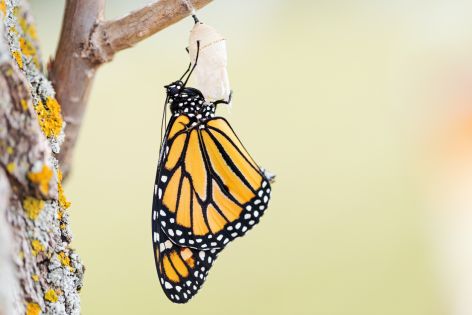Lessons From a Caterpillar’s Transformation to Butterfly
The transformation of a caterpillar into a butterfly is one of the most amazing occurrences in biology. What can it teach us about God’s purpose for us?

Caterpillars and butterflies are so different, it can be hard to believe they are the same creature.
Biologist Bernd Heinrich examined the two and noted how different the butterfly is from its early beginnings as a caterpillar.
Butterflies are winged and beautiful to behold. But they start their life as wormy and creepy caterpillars. They are interesting to look at no doubt, but not typically described as beautiful.
Caterpillars and butterflies seem to have almost nothing in common.
The differences between caterpillars and butterflies
Consider the following differences.
- Some caterpillars are pests that can destroy plants. With their strong jaws, they can chew up leaves. But butterflies only drink nectar, promoting plant growth by pollinating the flowers.
- Caterpillars have six true legs on their thorax, and many “false legs” (referred to as prolegs) on their abdomen. But butterflies have only six legs, and none of them are on their abdomen.
- Caterpillars walk slowly on their stubby legs. But butterflies fly long distances, in some cases thousands of miles.
- Caterpillars are sexless and cannot mate. But butterflies are either male or female and can mate and lay eggs.
- Caterpillars have simple eyes, each composed of a single lens, and can only see in black and white. Butterflies have compound eyes with multiple lenses and can see an array of colors.
- Caterpillars have small antennae that help them smell and find food. Butterflies have larger antennae to find flowers and mate. Butterflies even use their antennae as light receptors to detect the time of day, so they prepare for sleep when it gets dark. They can actually use their antennae to navigate and migrate long distances by detecting the sun’s position, like a sophisticated GPS.
If you didn’t know the butterfly started as a caterpillar, you wouldn’t assume they were the same creature.
What can the butterfly teach us?
God’s creation can teach us many things about God and His mind.
The apostle Paul wrote, “His invisible attributes are clearly seen, being understood by the things that are made, even His eternal power and Godhead” (Romans 1:20).
The transformation process from caterpillar to butterfly can serve as an instructive analogy of the process of conversion.
In other words, when God put the creation into existence, He embedded certain characteristics into it that reflect Himself. He didn’t just create it randomly, but instead created all things with careful consideration.
The transformation process from caterpillar to butterfly can serve as an instructive analogy of the process of conversion.
The transformation is called metamorphosis. The word metamorphosis is derived from two Greek words: meta, meaning change, and morphē, meaning form. So it literally means to change form.
The Bible reveals that a major part of God’s plan for us is that we also undergo a metamorphosis—to change form into something different than we are now.
After beginning life as an egg, a butterfly goes through three main stages:
- The caterpillar stage.
- The chrysalis stage.
- The butterfly stage.
Human beings, likewise, are destined to undergo a metamorphosis in three main stages.
Let’s examine this analogy a little closer.
The caterpillar stage (the natural carnal mind)
The caterpillar stage. Caterpillars are often a nuisance. They can consume a garden and wreak havoc as a pest.
Germany and the Netherlands are battling infestations of oak processionary moth caterpillars devouring their forests. These caterpillars even have toxic hairs that can cause eye irritation, rashes and other negative reactions in people.
In many ways, human beings are like the caterpillar. As caterpillars can cause destruction, so human beings have the potential to wreak great destruction—and we have. Jesus even said that we would destroy ourselves if He didn’t return to save us (Matthew 24:22).
In our current state, the Bible says, we inherently have carnal minds that are “enmity against God” (Romans 8:7). We don’t naturally obey God and do the things that lead to peace. In fact, we do just the opposite.
To learn more, read “What Is Human Nature?”
But the good news is that we aren’t destined to stay this way! As the caterpillar undergoes a transition in the chrysalis stage, so we must undergo a transition.
A metamorphosis.
The chrysalis stage (the metamorphosis occurs)
The chrysalis stage. The caterpillar is not quite a caterpillar, but it’s not quite a butterfly either. It’s in a state of transition. 
In the chrysalis, the caterpillar is not quite a caterpillar, but it’s not quite a butterfly either. It’s in a state of transition.
In the chrysalis, the caterpillar begins to shrink and shed its skin, and its organs dissolve. The caterpillar begins to die. But then, after a pause, a new creature begins to emerge.
Biologist Bernd Heinrich describes it this way: “The adult forms of these insects are actually new organisms . . . where the first one lives and dies . . . and then the other emerges.”
In like manner, those God calls undergo a similar process—a slow and gradual metamorphosis.
Our “old man” is to die (Ephesians 4:22; Colossians 3:9). But then a “new man” is to be created (Ephesians 4:24; Colossians 3:10). Just as the caterpillar dies and slowly becomes a new creature, we, too, must undergo a similar process. The old man must die and be re-created into the new man.
Christians are to live a life of consistent growth—putting off their old carnal character and putting on God’s holy, righteous character. It’s a slow process that continues from baptism until the day we die (or until Jesus Christ returns).
We are to be like the caterpillar in the chrysalis. We are no longer a caterpillar (the old man), but not yet a butterfly (a glorified spirit being). Instead, this life is a transition—a period of striving to grow in God’s righteousness. Christians are to become more and more like Jesus Christ every day.
A butterfly emerges
A butterfly emerges. At this point, a new organism has been created—nothing like its old self.
The DNA is now executing a different set of plans to make a new body.
Biologist Bernd Heinrich describes it this way: “‘There are indeed two very different sets of genetic instructions at work,’ he writes, and this switch, turning ‘caterpillar off,’ turning ‘butterfly’ on, means that ‘most of one body dies and the new life is resurrected in a new body.’”
Jesus told Nicodemus, a ruler of the Jews, that we must be born again to enter the Kingdom of God (John 3:1-7). This teaching confused Nicodemus, as it confuses people today.
Many teach that being “born again” is just something that occurs now when someone accepts Jesus into his or her heart. But the Bible doesn’t say this.
We will be fully transformed from human being to spirit being, just as a caterpillar is transformed from its former state into a butterfly.
In John 3:6, Jesus distinguished between a physical birth and a later spiritual birth: “That which is born of the flesh is flesh, and that which is born of the Spirit is spirit.”
There is a birth of the flesh (when we are born as a human being) and a second birth of the spirit (when we become spirit, as God is spirit).
Paul describes the same concept this way: “It [the human body] is sown a natural body, it is raised a spiritual body. There is a natural body, and there is a spiritual body” (1 Corinthians 15:44). The subject of 1 Corinthians 15 is about a resurrection from death and about what body the dead are raised in.
Paul further described this future transformation from flesh to spirit: “So also is the resurrection of the dead. The body is sown in corruption, it is raised in incorruption. It is sown in dishonor, it is raised in glory. It is sown in weakness, it is raised in power. It is sown a natural body, it is raised a spiritual body. There is a natural body, and there is a spiritual body” (verses 42-44).
To be fully “born of the spirit” is to be transformed from mortal flesh and blood to immortal and incorruptible spirit. For Christians called in this age, this will occur at the last trumpet blast when Jesus Christ returns to this earth (verse 52; 1 Thessalonians 4:16).
This is when we will be fully transformed from human being to spirit being, just as a caterpillar is transformed from its former state into a butterfly.
To learn more about this final stage in the process of conversion, read “The Gift of Eternal Life.”
God’s plan for us
In this life, our character must be transformed to become more like that of Jesus Christ. We must develop God’s very own character. Doing that prepares us to inherit a new life as a glorified spirit being, a child in God’s eternal family, and live forever. That is what God’s plan of salvation is all about!
Though we have a wormy start—we will have a flying finish!
Date Posted: September 30, 2022

 by Isaac Khalil
by Isaac Khalil

